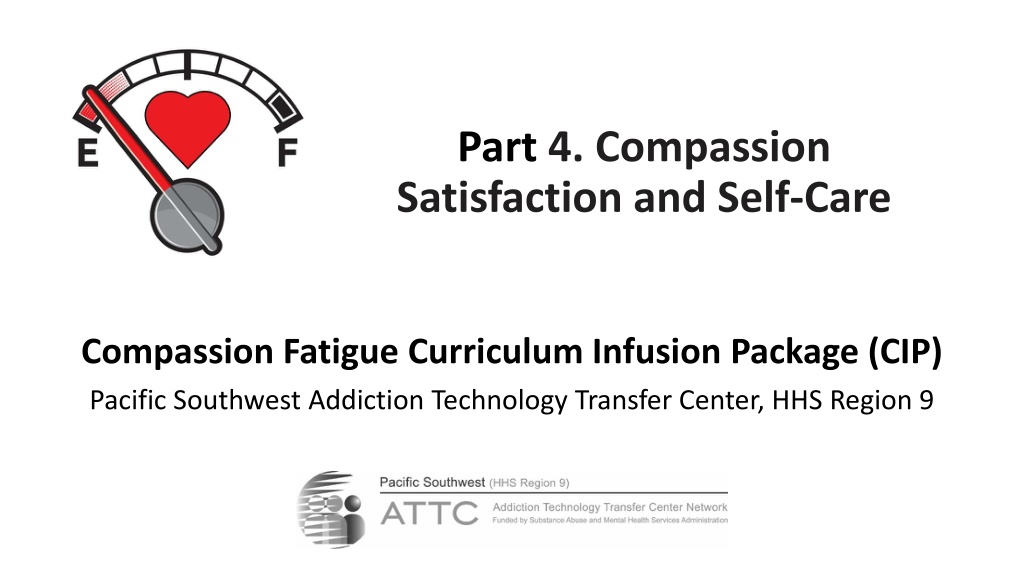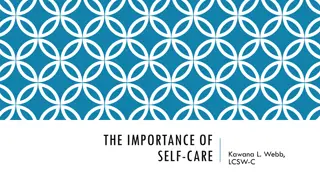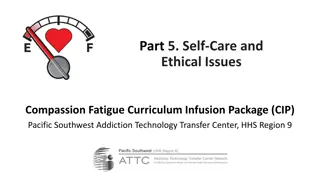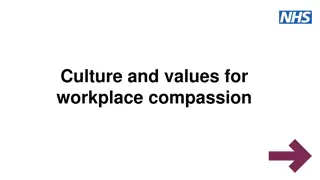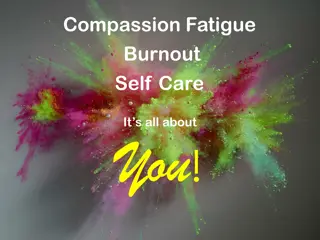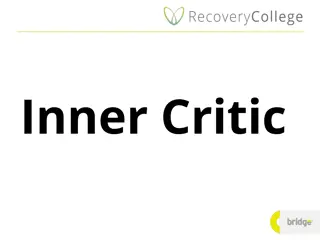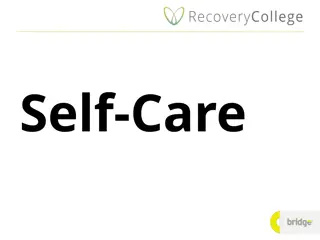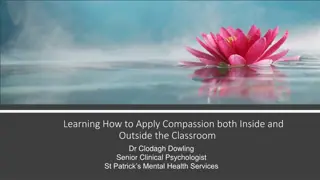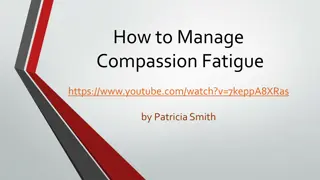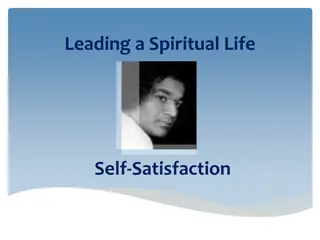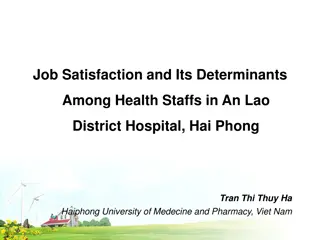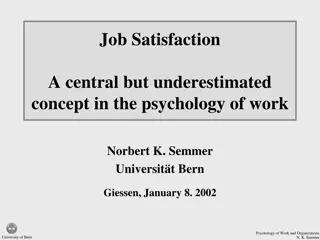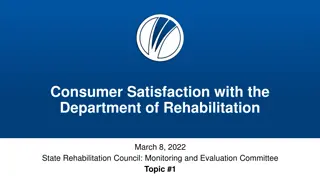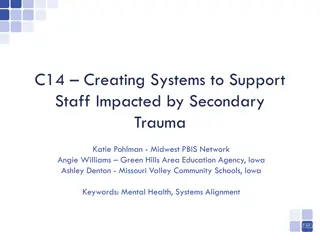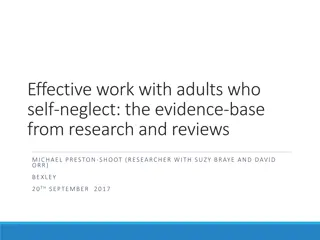Understanding Compassion Satisfaction and Self-Care in Human Service Professionals
Compassion Satisfaction emphasizes the positive aspects of helping others, leading to personal fulfillment and resilience in human service professionals. By focusing on empathy, kindness, and self-care, individuals can navigate the challenges of providing compassionate care while safeguarding against burnout and enhancing emotional well-being.
Download Presentation

Please find below an Image/Link to download the presentation.
The content on the website is provided AS IS for your information and personal use only. It may not be sold, licensed, or shared on other websites without obtaining consent from the author. Download presentation by click this link. If you encounter any issues during the download, it is possible that the publisher has removed the file from their server.
E N D
Presentation Transcript
Part 4. Compassion Satisfaction and Self-Care Compassion Fatigue Curriculum Infusion Package (CIP) Pacific Southwest Addiction Technology Transfer Center, HHS Region 9
Part 4 Outline Definition of compassion satisfaction and its relationship to compassion fatigue Self-Care and Self-Care Plans Wellness and Self-Compassion Mindfulness and Mindful Exercises for Organizations
Compassion Satisfaction A recent shift has occurred to focus on the positive aspects and experiences that occur in trauma and/or behavioral practice RATHER than just focusing on the negative aspects Compassion Satisfaction is about the pleasure a helper can experience from being able to help others and to make a positive difference in the world. A review of the literature revealed one common denominator for compassion fatigue- use of empathy and compassion as the driving factor that brought satisfaction
Compassion Satisfaction & Vicarious Resilience Compassion Satisfaction refers to those aspects of work that are rewarding and fulfilling to the human service professional (Conrad & Keller-Guenther, 2006; Stamm, 2005) May include positive interactions with clients, colleagues, the human service organization, or the helping community in general (Stamm, 2005) Trauma recovery has the potential to foster resilience and growth, not only in the client but in the clinician as well; New term is vicarious resilience (Hernandez, Gangsei,& Engstrom, 2007)
Compassion Satisfaction Comes from providing compassionate care which requires Kindness, Empathy, and Sensitivity There is also a moral element, whereby choosing not to show compassion may compound the pain or distress experienced by another person (Gilbert, 2013) Research findings suggest that helping professionals can gain considerable satisfaction from connecting with and supporting service users (Senreich et al., 2018) Compassion satisfaction is commonly identified as one of the most rewarding and motivating aspects of helping work that can also enhance feelings of personal accomplishment and fulfilment (Stamm, 2005; Cosley et al., 2010) Satisfaction with providing compassionate care can also offer protection against stress and burnout, an acknowledged risk factor for health and social care professionals, and help build emotional resilience (Kinman & Grant, 2016)
Clinician wellness serves as a protective factor against vicarious trauma for clinicians working with traumatized clients Foreman, 2018 Foreman, 2018
Wellness Wellness and wellbeing are the foundation of the therapy profession pursuit of wellness for the client and pursuit of wellness for the clinician (Cuellar et al., 2019) Pursuing wellness can be difficult for clinicians, especially with the depth of traumatic stories shared with them (Craig & Sprang, 2010; McKim & Smith-Adcock, 2014) Clinicians that are consistently exposed to client trauma experiences may be impaired and unable to care for clients, as well as being at an increased risk for vicarious trauma (Sadler-Gerhardt & Stevenson, 2012)
Self- Care Plans Self-care behaviors that are part of a plan may be more sustainable Development of a self-care plan is important and needs to include active coping strategies: physical health (exercise, proper nutrition, adequate sleep) emotional well-being (creative endeavors such as art or cooking, spiritual activities such as meditation or church seeking the social support of family and friends) Are likely to provide the greatest benefit (see Newell & MacNeil, 2010) 3 coping strategies found to have helped social workers manage compassion fatigue: Have a clear self-care plan Participate in activities or hobbies that restore energy Have a work-to-home transition plan that is part of the plan (Rienks, 2020)
Self Self- -Compassion Compassion Research on Self-Compassion has been rapidly growing Neff & Dahm, 2014) Neff proposed that Self-Compassion involves THREE components: extending KINDNESS and understanding to oneself rather than harsh self-judgment seeing one s experiences as part of the larger human experience rather than as separating and isolating (SENSE OF COMMON HUMANITY) holding one s painful thoughts and feelings in balanced awareness rather than over-identifying with them (MINDFULNESS) (Neff, 2003b p. 225) These components interact to foster compassion focused inward (Neff, 2003b) Self-Compassion is NOT self-centeredness, it helps to cultivate feelings of compassion for others (Gilbert & Procter, 2006; Neff, 2003a) Cultivating Self-Compassion has been shown to stimulate brain activity that evokes empathy and compassion for others (Longe et al., 2009)
Mindfulness and Mindfulness Training from and article by Martin-Cuellar et al., 2018, pp 359-360 Mindfulness state of being present through attention and awareness without judgment or other common filters (Martin-Cuellar et al., 2018) Mindfulness Training (page 360) Reduced clinicians experiences of stress, negative affect, rumination, and anxiety (McGarrigle & Walsh, 2011; Schomaker& Ricard, 2015; Shapiro et al., 2007) Is linked with a clinician s ability to know when they need to take time away or engage in self-care, which may serve as a buffer to the experience of compassion fatigue and heighten feelings of compassion satisfaction (Figley, 1995; Thieleman& Cacciatore, 2014; Valent, 2002; Thomas & Otis, 2010) Mindfulness plays a significant role as a protective factor. This corroborates with previous research that suggests that clinicians benefit from a mindful presence, which impacts their work with clients (Christopher & Maris, 2010; Greason & Welfare, 2013)
Quick Exercises & Tips for Using Mindfulness at Work Mindfulness Exercises Five Senses 3 Minutes Breathing Body Scan Self Compassion Pause Mindfulness in Meetings Pressley Ridge, n.d.
Example of a Mindfulness Exercise - Five Senses Notice five things you can see [pick something you don t normally pay attention to] Notice four things you can feel [examples, clothing texture or surface of the table] Notice three things you can hear [pay attention to noises in the background, such as birds chirping or an air conditioner running] Notice two things you can smell [try to notice things you typically filter out, pleasant or unpleasant] Notice one thing you can taste [take a drink, chew gum, or just pay attention to the current taste in your mouth] Pressley Ridge, n.d.
This ends Part 4 of the five-part Compassion Fatigue and the Behavioral Health Workforce Curriculum Infusion Package (CIP) Other parts of this CIP can be found in the Products & Resources Catalog on the Pacific Southwest ATTC website: http://www.psattc.org
